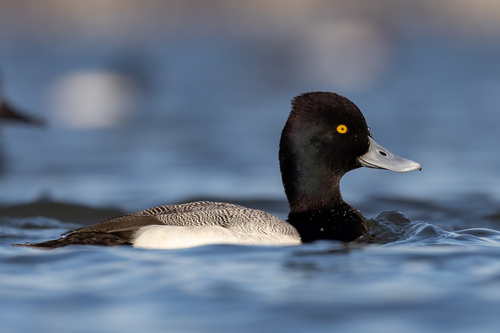
Lesser Scaup
The Lesser Scaup (*Aythya affinis*) is a small, diving duck native to North America. It is an important part of wetland ecosystems, playing a role in controlling aquatic invertebrate populations. Known for its distinctive blue bill in males during the breeding season, the Lesser Scaup is a visually striking species. It holds some cultural significance among birdwatchers and waterfowl hunters, although it is not typically a focal species in folklore or mythology.
38-48 cm
Length
68-78 cm
Wingspan
Least Concern
Conservation Status
Distribution
Breeds primarily in the boreal forests and prairie potholes of North America, from Alaska through central Canada and into the northern United States. Migrates south to the southern United States, Mexico, Central America, and the Caribbean for winter. Altitudinal range varies from sea level to inland lakes and ponds.
Lifespan
Average lifespan in the wild is not well-documented, but likely around 5-10 years. Captive individuals can live longer.
Lesser Scaup's Habitat
Habitat Types
Freshwater lakes, Ponds, Marshes, Bays, Estuaries
Climate Zones
Temperate, Boreal, Subarctic
Adaptations
Dense, waterproof plumage for insulation in cold water. Webbed feet positioned far back on the body, providing excellent propulsion underwater but making them awkward on land. Specialized bill structure for filtering food.
Variations
No recognized subspecies, but slight variations in size and plumage coloration may occur across their extensive range.
Appearance
Breeding Plumage
Breeding males have a glossy black head with a purplish sheen, black breast and tail, white sides and belly, and a finely vermiculated gray back. Females are mostly brown with a white patch near the base of the bill. Non-breeding males resemble females but retain some darker head and breast coloration.
Seasonal Feather Changes
Males molt into a duller, eclipse plumage after breeding, resembling females.
Sex Based Plumage Differences
Significant sexual dimorphism, especially during breeding season.
Notable Features
Blue-gray bill with a small black tip (more prominent in males), Yellow eyes, Rounded head shape
Diet and Feeding
Primary Foods
Aquatic invertebrates, Mollusks, Crustaceans, Insect larvae, Seeds of aquatic plants
Foraging Behavior
Dives underwater to forage, typically in relatively shallow water (less than 6 meters). Propels itself with its feet and uses its bill to strain food from the water or mud.
Specializations
Bill shape is adapted for scooping and filtering small prey items. Feet are positioned for efficient underwater movement.
Seasonal Diet Variations
Diet shifts with food availability. May consume more plant material during winter when invertebrates are less abundant.
Behavior
Social Structure
Forms large flocks during migration and winter. Breeding pairs are more dispersed and territorial.
Communication
Soft, purring calls by males during courtship, Quacks and growls by females, especially when defending young, Non-vocal communication through displays
Migration
Migrates in large flocks, often following major river systems or coastlines. Travels long distances between breeding and wintering grounds.
Territorial or Group Behaviors
Males defend a small territory around the nest during breeding season. Outside of breeding, they are highly social and form large aggregations.
Conservation
Threats
Habitat loss and degradation (wetland drainage and pollution), Climate change (affecting breeding habitat and food availability), Contaminants (pesticides, heavy metals), Hunting pressure (although regulated)
Protection Programs
North American Waterfowl Management Plan, Wetlands protection and restoration initiatives, Monitoring of populations and hunting regulations
Local National Laws
Protected under the Migratory Bird Treaty Act in the United States and Canada.
Population Trend
Declining
Population Estimates
Estimated at 3.8 million (but with significant uncertainty and evidence of ongoing decline).
Interesting Facts
Lesser Scaup are expert divers.
They can stay underwater for up to 20-25 seconds while foraging.
The name "Scaup" comes from their diet.
It refers to their preference for feeding on "scalp" or "scaup," a Scottish word for mussel beds.
They often mix with other diving duck species.
During migration and winter, Lesser Scaup can be found in mixed flocks with Greater Scaup, Ring-necked Ducks, and other diving ducks.
Faqs about Lesser Scaup
How can I tell a Lesser Scaup from a Greater Scaup?
Lesser Scaup are smaller, have a peaked head shape (Greater Scaup have a more rounded head), and the male's head has a purplish sheen (Greater Scaup have a greenish sheen). The nail (black tip) on the bill is also smaller in the Lesser.
Where can I see Lesser Scaup?
Look for them on lakes, ponds, and coastal bays during migration and winter. During breeding season, they are found in northern wetlands and prairie potholes.
Are Lesser Scaup endangered?
No, they are currently listed as Least Concern by the IUCN, but their populations have been declining in recent decades.
Copyright @ Nature Style Limited. All Rights Reserved.
 English
English